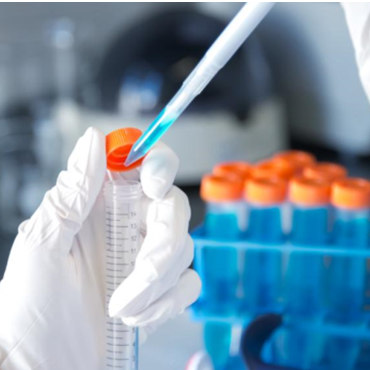How to improve the technique of pipetting with a pipette tip?
As the laboratory demands greater accuracy and precision, so does the importance of understanding and developing optimal pipetting tips techniques. Take your pipetting to the next level and see how much you've mastered by completing the steps we've covered below as part of your daily pipetting routine.
1. Pre-wet pipette tips
Aspirate and drain any sample fluid at least 3 times before aspirating the sample for delivery. Evaporation within the tip can cause significant loss of sample prior to delivery. Pre-wetting increases the humidity within the tip, thereby reducing any changes in sample evaporation. Using the same tip to deliver multiple samples without pre-wetting may result in smaller volumes for the first few samples. The need for pre-wetting increases when dealing with volatile samples (i.e. organic solvents).
2. Immerse the tip to the appropriate depth during aspiration
Before aspiration, fully immerse the tip under the meniscus. Large volume pipettes (1-5 mL) should be immersed 5-6 mm, while small volume pipettes should be immersed 2-3 mm. Too little immersion, especially with large volume pipettes, can result in air ingestion. Immersion too much can cause the sample to stick to the outside of the tip. Touching the bottom of the container with the tip may limit aspiration.
3. Sustained pause after suction
After aspirating the sample, leave the tip in the liquid for about a second. After the plunger is stopped, it will take some time for the liquid in the tip to complete its movement, otherwise, the volume will be too low. Make these pauses as consistent as possible.
4. Use consistent plunger pressure and speed
Press and release the plunger evenly and consistently. Try to apply the same pressure and speed when aspirating and dispensing each sample. Repeatable actions produce repeatable results.
5. Pull the pipette straight out
During sample aspiration, always hold the pipette vertically and avoid touching the sides of the container. After aspiration, pull the pipette straight out of the center of the container to pull the liquid out. This technique is especially important when pipetting small volumes (<50 µL). Holding the pipette at an angle will change the volume aspirated when removing it from the sample. Touching the sides of the container can cause wicking and volume loss due to surface tension.

6. Check tips before dispensing samples
Before dispensing, carefully remove droplets from the outside of the tip with a lint-free cloth, making sure to stay away from the tip opening. If the sample touches the tip at the opening, the absorbent material will quickly draw the sample away from the pipetting tip, and unnecessary wiping off the tip increases the chance of sample loss, so use it with caution.
Pipetting 96- and 384-well plates can be a very frustrating and tedious task.
7. Check the tips after dispensing the sample
When dispensing the sample, position the tip so that it touches the side of the container to deliver any residual sample that remains in the tip. Press your thumb on the second stop of the plunger and remove the tip to avoid re-aspirating the sample into the pipette tip. Make sure you see the sample leaving the tip.
8. Pipetting Using Standard Mode
Choose "Standard (or Forward) Mode" pipetting instead of "Reverse Mode" for all water samples, but for particularly viscous or volatile samples you might consider using it. If reverse mode is used for normal water samples, the pipette will often deliver more than the calibrated volume. On the other hand, using standard mode with viscous or volatile samples may result in insufficient delivery.
9. Use a suitable pipette
It is important to use a pipette with a volume range closest to the volume you plan to aspirate and dispense. If there is a slight difference between the minimum volume of the pipette and the volume being measured, your test accuracy will increase. For example, if you need to dispense 15 µL, a 1 mL pipette would be the wrong choice, and a 20 µL pipette would be ideal.
10. Use the correct pipette tips
Use high-quality tips designed for specific pipettes. For the most part, manufacturer tips perform well. Other brands may also be accepted if their performance has been demonstrated with a particular pipette model. Mismatched tips and pipettes can lead to inaccuracy, imprecision, or both. High-quality tips provide a hermetic seal without undue force and are constructed of high-quality materials with no molding defects, ensuring reliable liquid delivery.
11. Work under ambient temperature balance
Allow liquid and equipment to equilibrate at ambient temperature before beginning pipetting. The sample volume delivered by an air displacement pipette varies with air pressure, relative humidity, and vapor pressure of the liquid, all of which are temperature-dependent properties. Operating at a single, constant temperature minimizes this variation and improves overall accuracy.
12. Minimize pipette manipulation
Release the pipette and put it back in the pipette holder or set it down when not pipetting. Always wear gloves to reduce the transfer of body heat to the pipette and avoid handling pipette tips or sample containers that have not yet been pipetted. Body heat transferred during processing can disturb the temperature balance, resulting in changes in the amount delivered.
Supplier of pipette tips:
GENETURE is a group company focus on the field of clinical diagnosis and life sciences,provide one stop solution of Nucleic Acid Extraction and Analysis,including solution of COVID-19. Our main products including Nucleic acid extraction kit, Nucleic acid extractor, Magnetic beads, PCR kit, PCR system, etc.
Geneture provides one stop solution of Nucleic Acid Extraction and Analysis, including different kinds of pipette tips. Geneture All pipette tips are tested and certified and do not contain any detectable RNase, DNase, DNA, or pyrogen. If you have any requirements or questions about Geneture pipette tips, please feel free to contact us.
